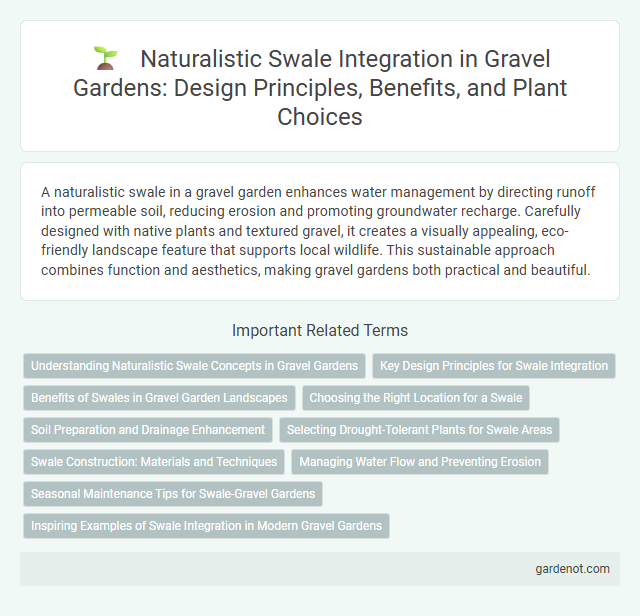A naturalistic swale in a gravel garden enhances water management by directing runoff into permeable soil, reducing erosion and promoting groundwater recharge. Carefully designed with native plants and textured gravel, it creates a visually appealing, eco-friendly landscape feature that supports local wildlife. This sustainable approach combines function and aesthetics, making gravel gardens both practical and beautiful.
Understanding Naturalistic Swale Concepts in Gravel Gardens
Naturalistic swales in gravel gardens function as shallow, vegetated channels designed to manage stormwater by promoting infiltration and reducing runoff. These swales integrate native plants and gravel substrates to mimic natural water flow patterns, enhancing biodiversity and supporting sustainable garden ecosystems. Understanding the role of swales within gravel landscapes is key to optimizing water conservation, soil health, and habitat creation.
Key Design Principles for Swale Integration
Naturalistic swales in gravel gardens enhance water management by utilizing permeable materials and native vegetation to promote infiltration and reduce runoff. Key design principles include contouring the swale along natural land slopes, ensuring gradual side slopes for stability, and incorporating drought-tolerant plants compatible with gravel substrates. Strategic swale placement supports biodiversity and complements the garden's ecological balance by directing water to sustain plant health while preventing erosion.
Benefits of Swales in Gravel Garden Landscapes
Naturalistic swales in gravel garden landscapes enhance water management by efficiently capturing and directing runoff, reducing erosion and promoting groundwater recharge. These gently sloped channels support diverse plant habitats, improving biodiversity and creating microclimates that thrive in well-drained, nutrient-poor soils. Integrating swales minimizes maintenance needs while sustaining healthy soil structure and promoting resilient, drought-tolerant garden ecosystems.
Choosing the Right Location for a Swale
Selecting the optimal location for a naturalistic swale involves analyzing the garden's topography to identify areas where water naturally accumulates or flows, ensuring efficient stormwater management. Positioning the swale along contour lines maximizes water infiltration and prevents soil erosion, promoting healthy plant growth in gravel gardens. Consider soil composition and proximity to existing vegetation to enhance the swale's functionality and integration within the natural landscape.
Soil Preparation and Drainage Enhancement
Soil preparation for a naturalistic swale in a gravel garden involves deep tilling to improve aeration and incorporating organic matter to boost soil fertility and structure. Enhancing drainage is achieved by shaping the swale to guide water flow effectively, using gravel and coarse sand layers to facilitate infiltration and prevent waterlogging. This combination ensures optimal moisture retention and supports healthy plant growth in the garden ecosystem.
Selecting Drought-Tolerant Plants for Swale Areas
Choosing drought-tolerant plants such as sedum, yarrow, and native grasses ensures optimal water retention and minimal maintenance in gravel garden swales. These species thrive in well-drained soils, enhancing soil structure while preventing erosion and promoting biodiversity. Strategic planting in swale areas maximizes stormwater absorption and supports resilient, eco-friendly landscapes.
Swale Construction: Materials and Techniques
Swale construction in gravel gardens relies on using permeable materials such as gravel, sand, and native soil to enhance water infiltration and prevent erosion. Techniques include shaping gentle, shallow channels lined with geotextiles to promote drainage while supporting plant growth. Incorporating organic mulch and strategically planting moisture-tolerant vegetation helps stabilize swale edges and improve soil retention.
Managing Water Flow and Preventing Erosion
Naturalistic swales in gravel gardens effectively manage water flow by channeling runoff into permeable zones, reducing surface water velocity and promoting groundwater infiltration. These swales are designed with gentle slopes and native vegetation that stabilize soil, prevent erosion, and enhance water absorption. Incorporating organic mulch and gravel further minimizes sediment displacement, ensuring sustainable erosion control and improved drainage within the garden ecosystem.
Seasonal Maintenance Tips for Swale-Gravel Gardens
Seasonal maintenance for naturalistic swale gravel gardens involves clearing accumulated debris and sediment to maintain optimal water flow and prevent clogging. Regularly inspecting and adjusting plantings ensures native species thrive, enhancing soil stability and moisture retention. Managing invasive weeds and replenishing gravel layers support the swale's ecological function and aesthetic appeal throughout the year.
Inspiring Examples of Swale Integration in Modern Gravel Gardens
Naturalistic swales in modern gravel gardens create efficient water management by capturing and infiltrating runoff while enhancing biodiversity with native plantings. Examples such as the gravel garden at the RHS Chelsea Flower Show feature curved swales combined with drought-resistant perennials, showcasing seamless integration of function and aesthetics. These designs promote sustainability by reducing irrigation needs and supporting pollinators in urban and suburban landscapes.
Naturalistic swale Infographic

 gardenot.com
gardenot.com